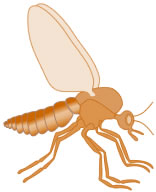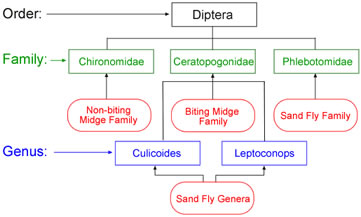Biting Midge - Bug of the Month - July
Biting midges, noseeums, punkies, and sand flies. You may have heard the names of these biting insects before, but do you know if the names are all referring to the same bug or different bugs? Unfortunately for us, nature has created millions of different insects making it hard for us to become familiar all of them. Along with all their scientific names, bugs often receive colloquial names or nicknames that allow us to more descriptively relate to the certain bug and its characteristics. Before going into scientific classifications, a discussion of the bugs in question may lead us to a clearer understanding about these different terms and their relationships to each other.
Biting Midges
The biting midge is the smallest blood-sucking insect on the earth and is about .04 inches (1 millimeter) long. It has two wings and does not have any scales on its wings or body. Like mosquitoes, biting midges have veins on their wings; however, the vein pattern is different. And like mosquitoes, only the females bite. Biting midges are most commonly found along seashores, rivers, and lakes.
Biting Midge Breeding
Female biting midges may lay their eggs in water, mud, leaves, under tree bark, in soil, or other moist surfaces. Females may lay 30-100 eggs at a time. The biting midge larvae are bright red in color and live in the water until the fully mature and are able to fly. This growth and maturing process can take anywhere from three to ten weeks.
Biting Midge Feeding
The female biting midges attack humans and feed on blood. The male biting midges do not bite and feed on nectar and vegetation. However, the females may also feed on vegetation and nectar. Biting midges appear in early spring and late autumn. Biting midges attack in great swarms and due to their intense biting, may cause extreme discomfort.
Noseeums
No-see-ums or noseeums are a nickname for biting midges. The terms 'biting midge' and 'no-see-um' are synonymous. The word 'no-see-um' is a fitting nickname for the biting midge, as biting midges are so small and very difficult to spot.
Biting Midge and Noseeum bites
A biting midge will go after any exposed skin. Within a few hours after a bite, you will start to feel acute itching at the spot of the bite. The irritation can last anywhere from a few days to several weeks depending on your sensitivity to the bite(s). As with all bug bites, don't scratch! Scratching the bite will only serve to increase your irritation and may cause infection if you scratch too much!
Biting Midge and Noseeum control
Biting midges are attracted by the common mosquito attractant: Octenol. By using a Mosquito Magnet product you will be guarding yourself against not only mosquitoes, but at the same time, biting midges as well! Be sure to check out traps that can control biting midges (noseeums).
Sand Flies
Sand flies have all the aforementioned characteristics of biting midges but also can carry diseases and viruses. They can transmit these dangerous diseases to people when they bite. Sand flies can carry: pappataci fever virus, kala azar, Oriental sore, espundia, and bartonellosis. However, these disease-carrying sand flies are found mostly in Africa, Asia, and South America.
Punkie
Punkie or punky is nickname for a sand fly. Perhaps due to their status and reputation as a dangerous pest, sand flies have been labeled punkies.
Scientific Classifications
Now that you understand where the terms noseeums and punkies come from, you may be wondering just exactly how sand flies and biting midges are related. In order to more exactly understand these similar pests, we need to look at scientific taxonomy. If you remember from your science classes, the order of scientific classification, from most general to most specific, is as follows: kingdom, phylum, class, order, family, genus, and species. We are most concerned with the later sections, specifically: order, family, and genus. The order of all "true" flies, ones with two wings is Diptera. All the bugs discussed fall under the family Diptera.
With the correct 'order', we can now look at the families. Chironomidae is the family that was originally given cover all types of midges. However, recently, in order to better differentiate between the many kinds of midges, another family was added: Ceratopogonidae. Ceratopogonidae is the family the contains all the biting midges.
Simple enough right? Unfortunately, the taxonomy becomes a bit more complicated when we start to look at sand flies and understand how they are classified. Multiple species of sand flies exist and they have not all been placed in the same area in scientific classification. Within the Ceratopogonidae, two genera exist: Culicoides and Leptoconops. These genera contain species of sand flies. However, these two genera do not contain all the species of sand flies. Within the order Diptera, another family exists: Phlebotomidae. Phlebotomidae contains all the species of sand flies that are not present within the biting midges family (Ceratopogonidae). In order for you to better understand these relationships view the chart on the left.
So are they the same bugs or not?
Yes and no. The nicknames are easy enough for us to understand; a punkie is a sand fly and a noseeum is a biting midge. But now the tricky questions are: "is a sand fly a biting midge?" and "is a biting midge a sand fly?" Due to the way the sand flies have been classified we can't give a definitive answer unless we know the species of the sand fly in question. Some species of sand flies are part of the biting midge family, while other species of sand flies are in a family all of their own.
Classifying bugs is certainly tricky work, and only to add to more confusion, we make up our own nicknames for bugs! Hopefully you now have a better grasp of biting midges and sand flies, as well as their respective nicknames: noseeums and punkies. All these words for bugs can certainly become confusing!






